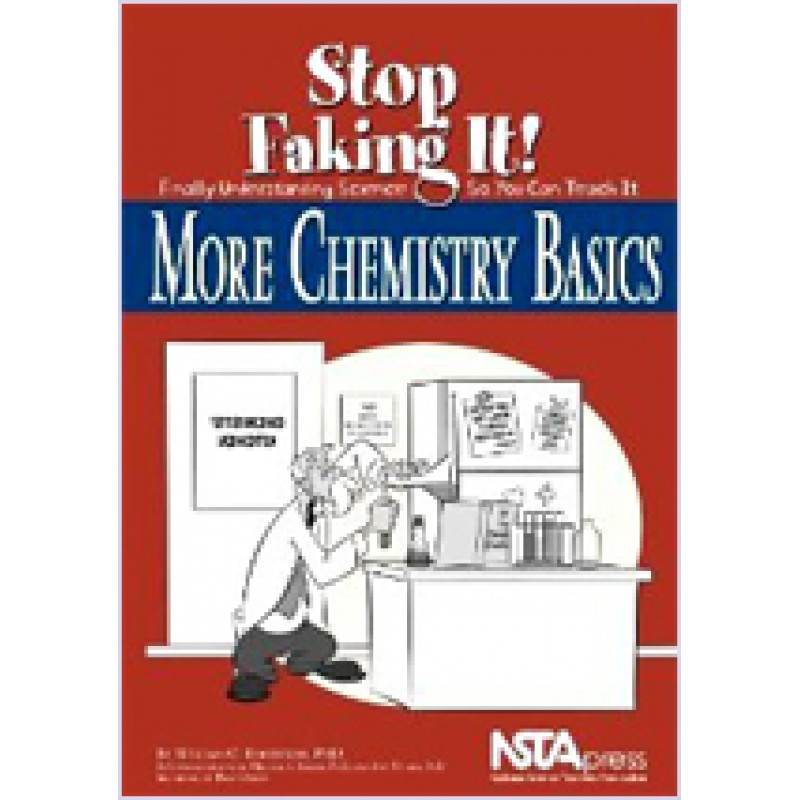More Chemistry Basics: Stop Faking It! Finally (Understanding Science So You Can Teach It)
| Author(s) | William C. Robertson, Ph.D. |
| ISBN10 | 1933531479 |
| ISBN13 | 9781933531472 |
| Format | Paperback |
| Pages | 153 |
| Year Publish | 2010 March |
Synopsis
Overwhelmed by orbitals? Terrified of thermodynamics? Agitated by acids and bases? Have no fear! This follow-up to the award-winning Chemistry Basics will clear up your chemistry woes.
In More Chemistry Basics, the ninth book in the bestselling Stop Faking It! series, author Bill Robertson introduces additional chemistry concepts, such as special reactions and half-lives, and expands on many previously discussed ideas, including electron energy levels and why we can’t know exactly what electrons are doing and where they are. Robertson explains science basics using easy-to-follow activities that help teachers learn the fundamentals and more.
Like other books in the Stop Faking It! series, More Chemistry Basics will prove invaluable for teachers, parents, and home-school providers who want to feel greater confidence in the content they teach. Robertson’s humorous and honest approach will help you brush up on chemistry concepts and feel more prepared—even excited—to teach chemistry to your students.
Review
The latest in the Stop Faking It! series extends Robertson's light-hearted but thorough explanations of basic chemistry. The topics this time include the gas laws and basic thermodynamics, the nature of electron orbitals and bonding, pH, redox reactions, electroplating, fluorescence, nuclear chemistry, and a brief introduction to organic isomers. There is an introductory chapter reviewing atomic structure and the periodicity of the elements (topics covered in Robertson’s first book), and there is an extensive glossary.
As with previous books in the series, each chapter contains activities to do to aid in conceptualizing and understanding what is highly abstract material. Each chapter concludes with a set of applications of the ideas to help the interested reader go further into a specific topic.
This book does a fine job of helping someone who does not have a formal background in chemistry understand the basics. Its intended audience of elementary and middle school teachers will find it a useful tool. This is the 12th book in NSTA's series of content updates for teachers.
--David Brock, AP Biology Teacher
In More Chemistry Basics, the ninth book in the bestselling Stop Faking It! series, author Bill Robertson introduces additional chemistry concepts, such as special reactions and half-lives, and expands on many previously discussed ideas, including electron energy levels and why we can’t know exactly what electrons are doing and where they are. Robertson explains science basics using easy-to-follow activities that help teachers learn the fundamentals and more.
Like other books in the Stop Faking It! series, More Chemistry Basics will prove invaluable for teachers, parents, and home-school providers who want to feel greater confidence in the content they teach. Robertson’s humorous and honest approach will help you brush up on chemistry concepts and feel more prepared—even excited—to teach chemistry to your students.
Review
The latest in the Stop Faking It! series extends Robertson's light-hearted but thorough explanations of basic chemistry. The topics this time include the gas laws and basic thermodynamics, the nature of electron orbitals and bonding, pH, redox reactions, electroplating, fluorescence, nuclear chemistry, and a brief introduction to organic isomers. There is an introductory chapter reviewing atomic structure and the periodicity of the elements (topics covered in Robertson’s first book), and there is an extensive glossary.
As with previous books in the series, each chapter contains activities to do to aid in conceptualizing and understanding what is highly abstract material. Each chapter concludes with a set of applications of the ideas to help the interested reader go further into a specific topic.
This book does a fine job of helping someone who does not have a formal background in chemistry understand the basics. Its intended audience of elementary and middle school teachers will find it a useful tool. This is the 12th book in NSTA's series of content updates for teachers.
--David Brock, AP Biology Teacher

